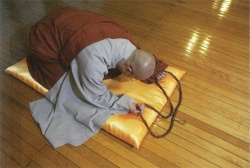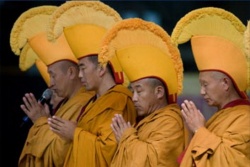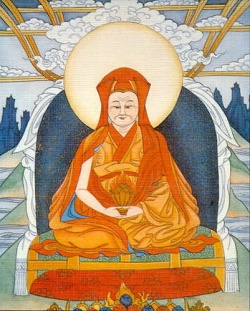Offering Paradigms in Tantric Literature
by John Makransky
Tantric ritual texts include the practices discussed above, but have other essential features as well. Buddhist tantric practice involves the identification of oneself with buddhahood as the key method to its attainment. Tantric texts often include, then, not only a mental creation of deities in front of the practitioner (mdun skyed) like the field of merit above, but also the mental creation of the practitioner him or herself as enlightened deity (bdag skyed). Offerings are made to a guru-deity generated in front (mdun skyed) for merit[page 323] and purification as above, but especially to receive the deity's power and blessing, visualized as nectar and light emitted from the mantra at its heart. Such divine power may be directed to mundane purposes, such as curing disease, bringing wealth, long life, etc., all ideologically subserved in the tantric literature to spiritual objectives. But the main purpose of the divine blessing is to empower the development of the practitioner through the stages of meditative realization. Offerings are also made to oneself as self-generated deity (bdag skyed) in manuals of tantric practice (sādhana, sgrubs thabs) whose purpose is to effect the total transmutation of one's body, speech and mind into those of the enlightened guru-deity. The Buddhist principle of nonduality, internalized and empowered by all preparatory ritual elements, now takes form in the identification of deity as cognitive object with deity as cognitive subject.
In tantric rites, all ritual elements are envisioned as pure appearances of the guru-deity's mind, characterized, in essence, as the gnosis directly cognizing voidness, or in Highest Yoga Tantras (rnal 'byor bla med rgyud), as the gnosis of voidness and bliss inseparable (bde stong dbyer med ye shes). Four general types of offering are basic to tantric practice: outer offering (phyi mchod)), inner offering (nang mchod), secret offering (gsang mchod) and thatness offering (de kho na nyid mchod). The outer offerings mentioned above (water, flowers, incense, lamps, etc.) are offered in ways ritually prescribed by tantric theory, involving special modes of mantra recitation, hand gesture and visualization (sngags, phyag rgya, ting nge 'dzin). What follows is a general description of tantric offering formulas commonly found in generation stage (bskyed rim) manuals of Highest Yoga Tantra.
All offerings in Highest Yoga Tantra must be consecrated as manifestions of the bliss-void gnosis (bde stong dbyer med ye shes) of the buddhas. Only a buddha (i.e., a tantric deity) has the power to do this. Hence, prior to offering, the practitioner first generates him or herself as deity (bdag skyed) in both mind and body (see Cozort, in this volume). Ordinary appearances are dissolved into the blissful gnosis of voidness. That gnosis projects a manifestation of the practitioner as deity. As deity, he or she is now ready to consecrate the offerings. First the "inner offering" is consecrated, which, in the practice of fierce deities, involves the transmutation of five meats (sha lnga) and five bodily fluids (bdud rtsi lnga) into an ocean of pure gnosis nectar, symbolizing the transmutation of[page 324] the psycho-physical components of saṃsāra (the senses, aggregates and elements) into those of enlightenment (tathāgatas, consorts, the five gnoses). The inner offering, represented by a cup of wine (chang) or tea, is cleared (bsang ba) of harmful influences by recitation of a fierce mantra and the projection of wrathful protectors, purified (sbyang ba) of the appearance of self-existence by meditative dissolution into voidness with recitation of the mantra: oṃ svabhāva śuddāḥ sarvadharmāḥ svabhāva śuddho 'ham ("oṃ all phenomena are intrinsically pure, I am intrinsically pure"), and then generated (bskyed pa) into the appearance of samsaric fleshes and fluids. The body, speech and mind of enlightenment, in the form of the syllables oṃ, āḥ, and hūṃ, bless (byin gyis brlab) these substances, transmuting them into a pure ocean of nectar of tremendous potency, which is used for further ritual applications (DNKD: 8b-10a; NGMT: 35a-36b; cf. Beyer, 1973: 158-159).
The outer offerings (flowers, incense, butter lamps, etc.) can now be consecrated. A drop of inner offering substance, envisioned as the potent nectar of bliss-void gnosis, is sprinkled over the outer offering substances with recitation of mantra and visualization as above to clear away harmful influences. The outer offerings are purified of their appearance of self-existence by dissolution into voidness as above. From that bliss-void gnosis is projected the appearance of boundless offering substances (water, flowers, incense, lamps, perfumes, foods, music). Though appearing as manifold offerings, their essence is gnosis and their effect when enjoyed is to elicit highest yogic bliss. With this in mind, the offerings are blessed as the body, speech and mind of the buddhas by the recitation of "oṃ" (Vajra Body); the name of each offering substance (arghaṃ, pādyaṃ, puṣpe, dhūpe, āloke, gandhe, naivedye, śabda); "āḥ" (Vajra Speech); "hūṃ" (Vajra Mind). Ritual hand gestures (mudrā, phyag rgya) symbolize each offering mimetically as it is blessed (DNKD: 10a-10b; NGMT: 36a-37b).4
The outer offerings, having been consecrated as the appearance of bliss-void gnosis, are now ready to be offered to the tantric field of merit, with the appropriate mantra and hand gesture for each. As the practitioner makes the hand gesture for each offering substance and says its mantra, offering goddesses are visualized emanating from the heart to present the offering to the field of merit in elegant dance. With hand gestures that represent the dancing movements of the goddesses, they are then visualized as returning and reabsorbing into the heart: oṃ (name of deity) arghaṃ[page 325] pādyaṃ puṣpe dhūpe āloke gandhe naivedye śabda pratīccha hūṃ svāhā ("oṃ (name of deity) accept this water for drinking, water for your feet, flowers, incense, light, perfume, food, and music, hūṃ svāha"). Visualizations of the varieties and methods of offering can be highly intricate (NGMT: 68a-73b). All space is filled with exquisite flowers, lights, smells, foods; the universe resonates with wonderful sounds. Sometimes the practitioner, using appropriate mantras and hand gestures, also emanates goddesses of the six senses to offer ritual representations of each sense to the field of merit: oṃ āḥ vajra ādarśe hūṃ, oṃ āḥ vajra vīṇe hūṃ, oṃ āḥ vajra gandhe hūṃ, oṃ āḥ vajra rāse hūṃ, oṃ āḥ vajra sparśe hūṃ, oṃ ah vajra dharme hūṃ ("oṃ āḥ Vajra Mirror, Lute, Perfume, Taste, Touch, Mental Object, hūṃ"). Next the inner offering is presented. Reciting oṃ āḥ hūṃ, the practitioner sprinkles the liquid toward the field of merit with the fingers while visualizing its presentation to the deities by goddesses (DNKD: 13a-14a; NGMT: 64b-74b, 85a-b; SDKR: 7a-7b). The presentation of outer and inner offerings to the practitioner as self-generated deity is done in much the same manner as above, with offering goddesses projected from his or her own heart presenting the offerings to the practitioner as deity with entourage.
The secret offering (gsang mchod) involves the visualized presentation of divine consorts to the principal deity. Their union generates a gnosis of highest yogic bliss, constituting the offering. The blissful gnosis induced by the secret offering, in its capacity of nondually cognizing voidness (bde stong dbyer med ye shes), constitutes the offering of thatness (de kho na nyid mchod pa) (DNKD: 14a; NGMT: 89b-90a, 93a).
Some early scholars, profoundly misunderstanding the sexual imagery found in Tibetan tantric art and literature, described it as the "debasement" of Buddhism (e.g., Waddell: 15). The Tibetan holocaust and subsequent diaspora, which has been a tragedy of profound dimensions for Tibetans, has helped us to clarify questions of this kind, for it has provided us with far greater access to Tibetans' own perspectives on their practices than had earlier been the case. It is now generally known that Tibetan tantric symbolism represents not, as was once thought, the triumph of animal instinct over spirituality, but precisely the opposite: a remarkable system for subordinating sexual imagery and instinct to the requirements of spiritual practice. Traditional Tibetan culture has never shared the West's obsessive concerns about sexuality. What Tibetan tāntrikas are very much concerned about, on the other hand,[page 326] is Buddhist enlightenment, and it is here that the imagery of psycho-sexual yoga is so highly valued: as the quintessential symbol of the nonduality of compassionate means and wisdom, and as a yogic method capable of generating the subtlest realization of voidness at the deepest stratum of human consciousness.
Often at the beginning of a tantric ritual, a ritual cake known as a gtor ma is offered to malevolent spirits in order to appease them, or to Dharma protectors (chos skyong) for protection from harms and interferences. At the conclusion of the ritual, gtor ma are again usually offered to some or all of the following: the principal tantric deities (yi dam) who embody all gurus, buddhas, etc., ḍākinīs (mkha 'gro ma) who are powerful guides on the tantric path, Dharma protectors, local spirits of all kinds, and sentient beings of the six realms. The gtor mas, made of barley flour dough decorated with colored butter, are consecrated by the same four-step procedure as for the outer and inner offerings above. The purpose of the offering is made clear upon its completion, when the practitioner recites verses of praise and makes supplications for protection, health, long life, success in all things mundane and supramundane, and for the enlightenment of all beings (DNKD: 40a-41a; Beyer, 1973: 219-222).
Another important tantric offering is a celebratory feast called a tshogs mchod (assembly offering). Delicious foods, beautifully arranged on the offering table, are consecrated by the four steps outlined above, offered to the merit field of deities, local spirits, and sentient beings, and then consumed as sacramental food by the assembled practitioners. This is a party, a thanksgiving celebration to which all mundane and supramundane beings are invited. At its conclusion, celebratory songs of tantric mahāsiddhas are joyfully sung (DTBM: 25-39). This ritual is of special importance to tantric practitioners who must perform it twice a month or more to maintain their precepts, to maintain a good relationship with the ḍākinīs, to receive powerful blessings from the deities, and to quickly realize the higher reaches of the tantric path (NGMT: 87a).
There are far too many Tibetan offering rituals, most of considerable complexity and multiple layers of meaning, to do them justice in this short space. Above are brief summaries of a few common offering formulas found in Tibetan Buddhist ritual literature. The reader interested in further study may want to consult Stephan[page 327] Beyer's book, The Cult of Tārā, the most comprehensive account of Tibetan offering rituals presently available in English, though it too is far from exhaustive.
Notes
[4] See Beyer, 1973: 147 for drawings of the hand gestures.




